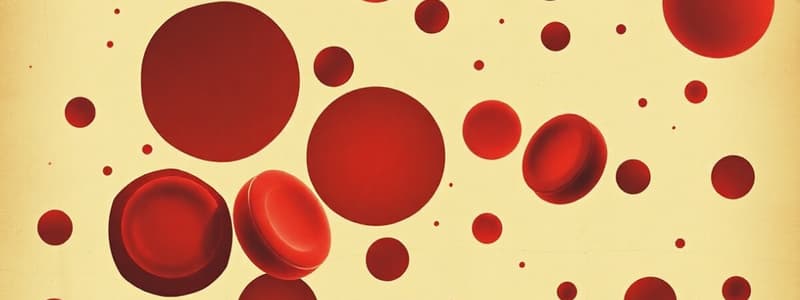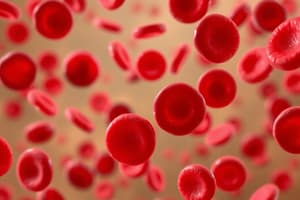Podcast
Questions and Answers
What is the primary site of erythropoiesis in the body?
What is the primary site of erythropoiesis in the body?
The balance between RBC production and destruction is an important aspect of erythropoiesis.
The balance between RBC production and destruction is an important aspect of erythropoiesis.
What is the earliest recognizable erythroid cell in the bone marrow?
What is the earliest recognizable erythroid cell in the bone marrow?
Erythropoiesis involves the proliferation and __________ of immature cells.
Erythropoiesis involves the proliferation and __________ of immature cells.
Match the stages of erythropoiesis with their descriptions:
Match the stages of erythropoiesis with their descriptions:
What is the primary hormone that regulates erythropoiesis?
What is the primary hormone that regulates erythropoiesis?
Erythropoiesis is the formation of white blood cells.
Erythropoiesis is the formation of white blood cells.
What is the average lifespan of a mature erythrocyte?
What is the average lifespan of a mature erythrocyte?
The destruction of red blood cells by macrophages is known as __________ destruction.
The destruction of red blood cells by macrophages is known as __________ destruction.
Which of the following factors are necessary for the formation of fully functioning red blood cells?
Which of the following factors are necessary for the formation of fully functioning red blood cells?
Match the components of the reticuloendothelial system (R.E.S.) with their functions:
Match the components of the reticuloendothelial system (R.E.S.) with their functions:
EPO levels increase when oxygen supply to renal tissues is high.
EPO levels increase when oxygen supply to renal tissues is high.
What percentage of the body's red blood cells are destroyed and replaced each day?
What percentage of the body's red blood cells are destroyed and replaced each day?
What is the primary coloration of the cytoplasm in the polychromatic normoblast?
What is the primary coloration of the cytoplasm in the polychromatic normoblast?
The mature erythrocyte has a diameter of 5 - 6 µm.
The mature erythrocyte has a diameter of 5 - 6 µm.
What type of cells are not usually seen in peripheral blood (PB)?
What type of cells are not usually seen in peripheral blood (PB)?
The size of the polychromatic normoblast ranges from _____ µm in diameter.
The size of the polychromatic normoblast ranges from _____ µm in diameter.
Match the following erythrocyte stages with their characteristics:
Match the following erythrocyte stages with their characteristics:
Which erythrocyte stage is characterized by the presence of a small, dense nucleus?
Which erythrocyte stage is characterized by the presence of a small, dense nucleus?
Mitochondria are evident in the orthochromatic normoblast.
Mitochondria are evident in the orthochromatic normoblast.
What is the typical staining method used to observe reticulocytes?
What is the typical staining method used to observe reticulocytes?
Flashcards
Erythropoiesis
Erythropoiesis
Regulated process of red blood cell (RBC) production in the bone marrow.
Erythron
Erythron
The entire mass of mature and immature RBCs in the body.
Stages of Erythropoiesis
Stages of Erythropoiesis
Includes proliferation and maturation of RBC precursors.
Proerythroblast
Proerythroblast
Signup and view all the flashcards
Early Erythroblast
Early Erythroblast
Signup and view all the flashcards
Nucleus of erythrocytes
Nucleus of erythrocytes
Signup and view all the flashcards
Cytoplasm of erythrocytes
Cytoplasm of erythrocytes
Signup and view all the flashcards
Polychromatic normoblast
Polychromatic normoblast
Signup and view all the flashcards
Ortho chromatic normoblast
Ortho chromatic normoblast
Signup and view all the flashcards
Polychromatophilic erythrocyte
Polychromatophilic erythrocyte
Signup and view all the flashcards
Reticulocyte
Reticulocyte
Signup and view all the flashcards
Mature erythrocytes
Mature erythrocytes
Signup and view all the flashcards
Size of basophilic normoblast
Size of basophilic normoblast
Signup and view all the flashcards
Lifespan of RBCs
Lifespan of RBCs
Signup and view all the flashcards
Erythropoietin (EPO)
Erythropoietin (EPO)
Signup and view all the flashcards
EPO Production Regulation
EPO Production Regulation
Signup and view all the flashcards
Essential Factors for Erythropoiesis
Essential Factors for Erythropoiesis
Signup and view all the flashcards
Reticuloendothelial System (R.E.S.)
Reticuloendothelial System (R.E.S.)
Signup and view all the flashcards
Ineffective Erythropoiesis
Ineffective Erythropoiesis
Signup and view all the flashcards
Destruction of RBCs
Destruction of RBCs
Signup and view all the flashcards




